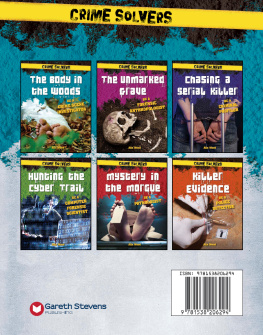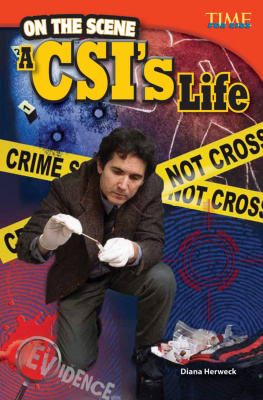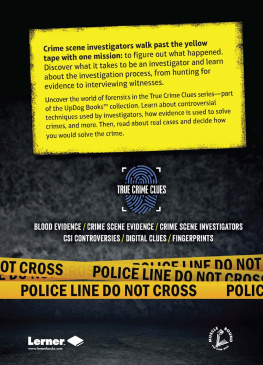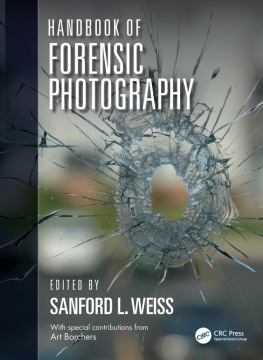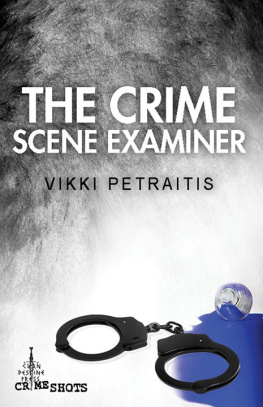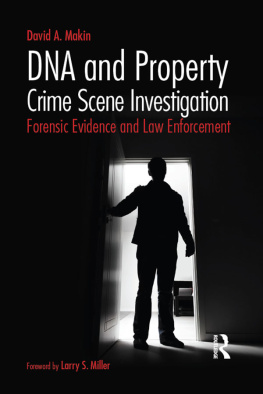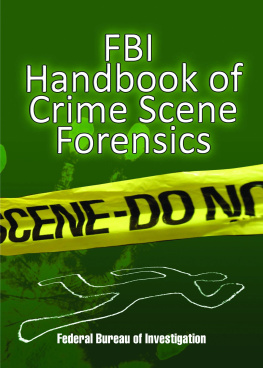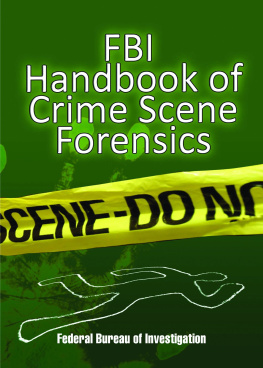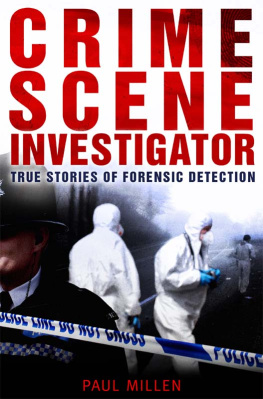The Crime Scene
A Visual Guide
Marilyn T. Miller
Peter Massey
Table of Contents
Copyright
Academic Press is an imprint of Elsevier
125 London Wall, London EC2Y 5AS, UK
525 B Street, Suite 1800, San Diego, CA 92101-4495, USA
225 Wyman Street, Waltham, MA 02451, USA
The Boulevard, Langford Lane, Kidlington, Oxford OX5 1GB, UK
Copyright 2016 Elsevier Inc. All rights reserved.
No part of this publication may be reproduced or transmitted in any form or by any means, electronic or mechanical, including photocopying, recording, or any information storage and retrieval system, without permission in writing from the publisher. Details on how to seek permission, further information about the Publishers permissions policies and our arrangements with organizations such as the Copyright Clearance Center and the Copyright Licensing Agency, can be found at our website: www.elsevier.com/permissions.
This book and the individual contributions contained in it are protected under copyright by the Publisher (other than as may be noted herein).
Notices
Knowledge and best practice in this field are constantly changing. As new research and experience broaden our understanding, changes in research methods, professional practices, or medical treatment may become necessary.
Practitioners and researchers must always rely on their own experience and knowledge in evaluating and using any information, methods, compounds, or experiments described herein. In using such information or methods they should be mindful of their own safety and the safety of others, including parties for whom they have a professional responsibility.
To the fullest extent of the law, neither the Publisher nor the authors, contributors, or editors, assume any liability for any injury and/or damage to persons or property as a matter of products liability, negligence or otherwise, or from any use or operation of any methods, products, instructions, or ideas contained in the material herein.
ISBN: 978-0-12-801245-1
British Library Cataloguing-in-Publication Data
A catalogue record for this book is available from the British Library
Library of Congress Cataloging-in-Publication Data
A catalog record for this book is available from the Library of Congress
For information on all Academic Press publications visit our website at http://store.elsevier.com/

Acquisition Editor: Elizabeth Brown
Editorial Project Manager: Joslyn Chaiprasert-Paguio
Production Project Manager: Lisa Jones
Designer: Matthew Limbert
Typeset by TNQ Books and Journals
www.tnq.co.in
Printed and bound in China
Dedication
Marilyn T. Miller
As I look through the many book offerings in crime scene investigation I never cease to be amazed. I will never believe that one television series is responsible for the explosion of interest in crime scene investigation. I believe it is a public awakening centered on using physical evidence and not just solving a case by confession or eyewitnesses. The explosion has helped keep me working with amazing crime scene professionals and equally amazing students who cannot wait to get the job done! I dedicate this text book to those professionals and students. Thank you for wanting to learn and to always do the best job they can do. This textbook is the result of a war storytelling session with Pete. On my goodness, how I treasure our friendship! Patience and pride from home is important too! So, to home, thanks for the space and I hope to always make you proud.
Peter Massey
We have spent countless hours teaching and training students and professionals the proper and correct way in which to recognize, evaluate, document, and collect evidence from forensic scenes. It is for those past students and those who will follow that drive the passion to offer this book. To my children, Emily, Abigail, Rebecca, and Zacharyyou are never too old to grow and learnand to give back. To Brooke and Sharon thank you for your contributions. Marilynmere words cannot express my love and respect for you, and for your support and guidance throughout our friendship. To my best friend, soul mate, and absolute love of my life, my wife Sandy, thank you for all of your support and sacrifices for me.
Foreword
I appreciate the opportunity to introduce this new textbook on crime scene investigation and procedures by a pair of authors who have long and varied theoretical and practical experience in this area. This book emphasizes the visualprinciples are highlighted and discussed using crime scene visuals as centerpieces. This approach follows the idea that the use of visuals with text is a more effective instructional tool than text alonean idea with considerable support in the learning techniques literature.
The book is divided into three parts, each containing several chapters. , Concluding Processes, we learn about reconstruction activities, current technologies, and some concluding remarks by the authors.
looks at initial procedures. Highlights here include the actions of first responders and initial scene survey and security implementation. Multilevel scene security procedures insure that the core scene is properly protected while still providing work and staging areas for authorized personnel.
In discusses searching for evidence at the scene. There are different methods of searching, applicable to different scenes and circumstances. But as noted, the key to thorough searches is a consideration of the overall scene and circumstances. Specialized lighting and other equipment or specialized chemicals may also be helpful or necessary. In recent years, laboratory analytical methods have gotten more and more sensitive. This development makes it necessary for crime scene investigators to don protective clothing and footwear to keep any of their own traces from contaminating the scene (as well as to protect them from any potentially hazardous materials within the scene).
is a recap of the crime scene process emphasizing important principles. This thinking hearkens back to the uses of physical evidence discussed earlier. To be useful to the case, the physical evidence must have probative value, i.e., it must be able to tell investigators something relevant about the case.
Each chapter is complete with learning objectives and discussion questions. Overall, the book is an outstanding introduction to crime scene investigation. The visual approach, which is novel, should be helpful to practicing and aspiring crime scene investigators on many levels, and will be an important pedagogic addition to the crime scene investigation literature.
R.E Gaensslen, PhD , Professor Emeritus, Forensic Science University of Illinois, Chicago
Preface
Crime scene investigation is about details and experience. Crime scene investigation skills are learned by doing and trying. But how do you get the skills and experience without actually working a crime scene? There are many fine textbooks out there that address the issue of crime scene investigationsome are just about the scene and some are about the scene and the laboratory testing of the evidence from the scene. So, why yet another book on crime scene investigation? This textbook is different, it briefly describes and then puts the visual experience in the face of the user. Blooms taxonomy of learning shows that students learn better when they can visualize and then apply the skills while hearing new topics or ideas. This text provides the visual aspect of learning crime scene investigation. The application of skills should follow for the student. This text does not address the hands-on learningthere are other texts for that purpose.


